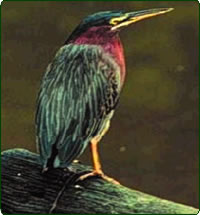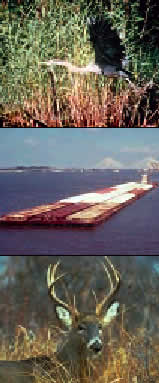 |
The Approach
The EMP Habitat Needs Assessment was designed to help guide future
Habitat Rehabilitation and Enhancement Projects on the UMRS. To
identify habitat needs, historical, existing, forecast, and desired
future conditions were compared. Issues of scale are important in
this regard because ecological processes and needs vary at the system,
reach, and pool levels. In addition, a wide variety of habitat characteristics
must be addressed including habitat fragmentation, connectivity,
and diversity. To accomplish this assessment, a GIS tool and a new
floodplain vegetation successional model were developed. These tools
allow geomorphic and land cover characteristics to be translated
into the potential for species to occur.
|
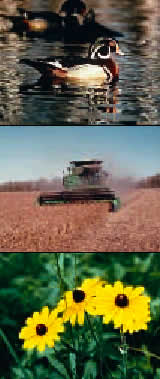 |
|
|
The Results
Over time, the landscape, land use, and hydrology of the Upper Mississippi
River and its basin have changed. Much of the grasslands, wetlands, and
forests have been converted to agriculture use, which now accounts for
50 percent of the floodplain. Impoundment, channelization, and levee construction
have altered the hydrologic regime and sedimentation patterns, resulting
in loss of backwaters, islands, and secondary channels. 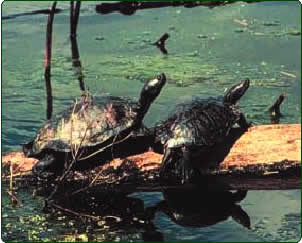 While
future changes in broad geomorphic features are expected to be relatively
small, habitat degradation is expected to continue. There is a broadly
recognized need among resource managers and scientists for improved habitat
quality, increased habitat diversity, and a closer approximation of pre-development
hydrologic variability. While
future changes in broad geomorphic features are expected to be relatively
small, habitat degradation is expected to continue. There is a broadly
recognized need among resource managers and scientists for improved habitat
quality, increased habitat diversity, and a closer approximation of pre-development
hydrologic variability.
The Habitat Needs Assessment identified clear differences in habitat types
and conditions among river reaches. Those differences are largely related
to the amount and distribution of public land, degree of floodplain development,
the geomorphic form of the river, and the effects of impoundment for navigation.
The differences also suggest that habitat needs and restoration objectives
will vary by river reach and pool.
|
|
The Habitat Needs Assessment yielded gross quantitative and qualitative
estimates of habitat needs both system-wide and within river reaches.
These estimates provide the first approximation of a set of system-wide
objectives for Habitat Rehabilitation 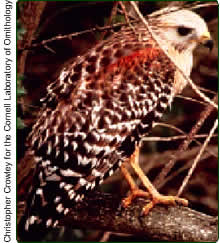 and
Enhancement Projects. While they do not offer quantitatively precise goals,
they will help focus future planning on the most important geomorphic
processes both system-wide and in specific river reaches. However, perhaps
the greatest contribution this first Habitat Needs Assessment has made
is the development of new and improved tools for future habitat planning.
In particular, the GIS Query tool will help evaluate the potential distribution
of species and habitat area types throughout the UMRS. While the results
of the Habitat Needs Assessment are not a substitute for the more detailed
and spatially explicit planning that will be done at the pool scale, it
has provided new tools for that planning. and
Enhancement Projects. While they do not offer quantitatively precise goals,
they will help focus future planning on the most important geomorphic
processes both system-wide and in specific river reaches. However, perhaps
the greatest contribution this first Habitat Needs Assessment has made
is the development of new and improved tools for future habitat planning.
In particular, the GIS Query tool will help evaluate the potential distribution
of species and habitat area types throughout the UMRS. While the results
of the Habitat Needs Assessment are not a substitute for the more detailed
and spatially explicit planning that will be done at the pool scale, it
has provided new tools for that planning.
|





 While
future changes in broad geomorphic features are expected to be relatively
small, habitat degradation is expected to continue. There is a broadly
recognized need among resource managers and scientists for improved habitat
quality, increased habitat diversity, and a closer approximation of pre-development
hydrologic variability.
While
future changes in broad geomorphic features are expected to be relatively
small, habitat degradation is expected to continue. There is a broadly
recognized need among resource managers and scientists for improved habitat
quality, increased habitat diversity, and a closer approximation of pre-development
hydrologic variability.  and
Enhancement Projects. While they do not offer quantitatively precise goals,
they will help focus future planning on the most important geomorphic
processes both system-wide and in specific river reaches. However, perhaps
the greatest contribution this first Habitat Needs Assessment has made
is the development of new and improved tools for future habitat planning.
In particular, the GIS Query tool will help evaluate the potential distribution
of species and habitat area types throughout the UMRS. While the results
of the Habitat Needs Assessment are not a substitute for the more detailed
and spatially explicit planning that will be done at the pool scale, it
has provided new tools for that planning.
and
Enhancement Projects. While they do not offer quantitatively precise goals,
they will help focus future planning on the most important geomorphic
processes both system-wide and in specific river reaches. However, perhaps
the greatest contribution this first Habitat Needs Assessment has made
is the development of new and improved tools for future habitat planning.
In particular, the GIS Query tool will help evaluate the potential distribution
of species and habitat area types throughout the UMRS. While the results
of the Habitat Needs Assessment are not a substitute for the more detailed
and spatially explicit planning that will be done at the pool scale, it
has provided new tools for that planning.